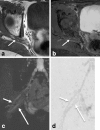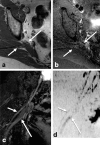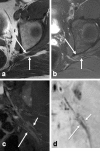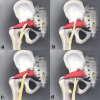Sciatic neuromuscular variants on MR neurography: frequency study and interobserver performance
- PMID: 28830192
- PMCID: PMC5963375
- DOI: 10.1259/bjr.20170116
Sciatic neuromuscular variants on MR neurography: frequency study and interobserver performance
Abstract
Objective: To evaluate the frequency of sciatic neuromuscular variants on MR neurography and determine the interobserver variability.
Methods: A retrospective evaluation of 137 consecutive lumbosacral plexus magnetic resonance neurography examinations was performed. All examinations were performed using nerve selective 3D imaging and independently reviewed by two readers for the presence of sciatic neuromuscular variants and piriformis muscle asymmetry. Inter- and intraobserver performance were evaluated.
Results: There were a total of 44/268 (16.4%) extremities with sciatic neuromuscular variants. The interobserver performance in the identification of sciatic nerve variants was excellent (kappa values from 0.8-0.9). There was a total of 45/134 (33.6%) patients with piriformis muscle asymmetry. Of these, 7/134 (5.2%) had piriformis muscle atrophy and 38/134 (28.4%) had piriformis muscle hypertrophy. The interobserver performance in the identification of piriformis muscle atrophy and hypertrophy was moderate to good (kappa values from 0.39-0.61). The intraobserver performance revealed kappa values of 0.735 and 0.821 on right and left, respectively.
Conclusion: Sciatic neuromuscular variants and piriformis muscle asymmetry are frequent on lumbosacral plexus MRN with moderate to excellent interobserver performance. Advances in knowledge: Sciatic neuromuscular variants and piriformis asymmetry on MR neurography are frequent and the prevalence is similar to cumulative prevalence from available scientific series. Interobserver performance for identification of sciatic neuromuscular variants is excellent, and moderate-good for piriformis muscle asymmetry.
Figures






Similar articles
-
Variant Sciatic Nerve Anatomy in Relation to the Piriformis Muscle on Magnetic Resonance Neurography: A Potential Etiology for Extraspinal Sciatica.Tomography. 2023 Feb 22;9(2):475-484. doi: 10.3390/tomography9020039. Tomography. 2023. PMID: 36960998 Free PMC article.
-
Magnetic resonance neurography in extraspinal sciatica.Arch Neurol. 2006 Oct;63(10):1469-72. doi: 10.1001/archneur.63.10.1469. Arch Neurol. 2006. PMID: 17030664
-
Sciatica of nondisc origin and piriformis syndrome: diagnosis by magnetic resonance neurography and interventional magnetic resonance imaging with outcome study of resulting treatment.J Neurosurg Spine. 2005 Feb;2(2):99-115. doi: 10.3171/spi.2005.2.2.0099. J Neurosurg Spine. 2005. PMID: 15739520
-
[Imaging of the lumbosacral plexus : Diagnostics and treatment planning with high-resolution procedures].Radiologe. 2017 Mar;57(3):195-203. doi: 10.1007/s00117-017-0222-2. Radiologe. 2017. PMID: 28213852 Review. German.
-
Case report and review of the potential role of the Type A piriformis muscle in dynamic sciatic nerve entrapment variant of piriformis syndrome.Surg Radiol Anat. 2020 Oct;42(10):1237-1242. doi: 10.1007/s00276-020-02440-8. Epub 2020 Feb 28. Surg Radiol Anat. 2020. PMID: 32112284 Review.
Cited by
-
An Updated Review of Magnetic Resonance Neurography for Plexus Imaging.Korean J Radiol. 2023 Nov;24(11):1114-1130. doi: 10.3348/kjr.2023.0150. Korean J Radiol. 2023. PMID: 37899521 Free PMC article. Review.
-
Variant Sciatic Nerve Anatomy in Relation to the Piriformis Muscle on Magnetic Resonance Neurography: A Potential Etiology for Extraspinal Sciatica.Tomography. 2023 Feb 22;9(2):475-484. doi: 10.3390/tomography9020039. Tomography. 2023. PMID: 36960998 Free PMC article.
-
Magnetic Resonance Neurography for Evaluation of Peripheral Nerves.J Brachial Plex Peripher Nerve Inj. 2021 May 14;16(1):e17-e23. doi: 10.1055/s-0041-1729176. eCollection 2021 Jan. J Brachial Plex Peripher Nerve Inj. 2021. PMID: 34007307 Free PMC article. Review.
-
Is it painful to be different? Sciatic nerve anatomical variants on MRI and their relationship to piriformis syndrome.Eur Radiol. 2018 Nov;28(11):4681-4686. doi: 10.1007/s00330-018-5447-6. Epub 2018 Apr 30. Eur Radiol. 2018. PMID: 29713768
-
Evaluation of the Interrater Reliability of Sonographic Measurements of Muscle Thickness of 38 Piriformis Muscles in 19 Patients with Piriformis Syndrome.Med Sci Monit. 2024 Apr 15;30:e943720. doi: 10.12659/MSM.943720. Med Sci Monit. 2024. PMID: 38616430 Free PMC article.
References
-
- Bardeen CR, Elting AW. A statistical study of the variations in the formation and position of the lumbosacral plexus in man. Anatomical Record 1901; 19: 209–32.
-
- Trotter M. The relation of the sciatic nerve to the piriformis muscle in American whites and negroes. Anat Rec . 1932; 52: 321–3. DOI: https://doi.org/10.1002/ar.1090520404 - DOI
-
- Ming-Tzu P'an. The relation of the sciatic nerve to the piriformis muscle in the Chinese. Am J Phys Anthropol 1941; 28: 375–80. DOI: https://doi.org/10.1002/ajpa.1330280403 - DOI
-
- Misra B. The relations of the sciatic nerve to the piriformis in Indian cadavers. J Anat Soc India 1954; 3: 28–33.
MeSH terms
LinkOut - more resources
Full Text Sources
Other Literature Sources
Medical

